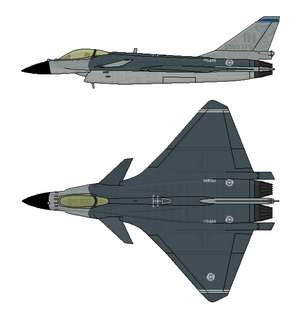F-28 Viper
| Layartebian Defense Corporation F-28 Viper | |
|---|---|

| |
| (Artwork by Mist) | |
| Role | Multirole fighter |
| National origin | |
| Manufacturer | Layartebian Defense Corporation |
| First flight | 17 June 1994 |
| Introduction | 1 April 2002 |
| Status | In-Service |
| Primary users | Imperial Layartebian Air Force Imperial Layartebian Navy |
| Produced | 2004 - Present |
The Layartebian Defense Corporation F-28 Viper is a twin-engine supersonic multirole fighter aircraft originally designed for the Imperial Layartebian Military. More Vipers have been produced than any other supersonic, Layartebian, jet fighter. The Viper is an all-weather, 4.5 generation aircraft similar to the Dassault Rafale and the Eurofighter Typhoon.
The Viper's key features include a frameless, bubble canopy for superior visibility, a side-mounted control stick and throttle, dual engines, and a large, delta wing. The aircraft makes heavy use of fly-by-wire systems, making it a highly agile aircraft, especially when combined with thrust vectoring engines. The fighter has an internal cannon and 14 hardpoints for air-to-air and air-to-ground ordnance.
The Viper is the most numerous fighter in Layartebian service and it is the most exported Layartebian fighter aircraft of all time. The Viper forms the backbone of several foreign air forces and navies.
Development
Origins
The origin of the F-28 Viper stems from the 1980s when the F-16 Fighting Falcon was introduced to service. Originally planned to be a lightweight fighter for air superiority, the aircraft ballooned into a multirole workhorse for the Imperial Layartebian Air Force. However, the design had some flaws and teething problems with the first variants did not sit well with brass. Wire chafing caused several prominent crashes, killing multiple pilots in the 1980s and though these problems were largely rectified by the 1990s, especially with the F-16C/D variants, the initial troubles left a sore memory of the aircraft. As if these initial problems weren't enough, limitations on range and payload for the Falcon ultimately doomed the nimble, agile fighter in the eyes of the brass.
In the early 1990s, the Ministry of Defense began a new fighter program dubbed the Joint Multirole Fighter Program or JMF Program. At the time, the British Aerospace EAP, the Mirage 4000, and the Dassault Rafale had all taken to the skies with technological demonstrators. The EAP would eventually become the Typhoon, while the Mirage 4000 was canceled in favor of the Rafale. It was from these aircraft, along with others, that the JMF Program would take its influence.
Early on in the JMF Program, designers conceded that a delta wing would be necessary for the type of ordnance, range, and agility requirements placed on the JMF. In addition, the debut of stealth aircraft such as the F-117 Nighthawk and the B-2 Spirit guaranteed that some attention would need to be paid to stealth, albeit the JMF Program was never required to procure a stealth fighter, that was left for other programs. The aircraft had to have a top speed in excess of Mach 2 at altitude and in excess of Mach 1.1 at sea level and it had to have two engines, which was a major distinction from the Falcon, which was a single-engine aircraft. Some in the Ministry of Defense believed that the single-engine of the Falcon contributed to its high accident rate and, for the aircraft to be accepted by the navy, it had to have two engines.
What resulted was the YF-28, which first flew on June 17, 1994. The aircraft bore a rather unique design while having the same, general appearance as its contemporary, soon-to-be 4.5 generation fighters. On its first test flight, the fighter was taken up to transonic speed and flown through several maneuvers not typically done for a first test flight. Handling was superb and performance issues were nonexistent. On the third test flight, the aircraft exceeded supersonic flight and on its seventeenth test flight, it reached a top speed of Mach 2.05 at an altitude of 36,500 feet (11,125 meters).
Fifteen prototype YF-28s were constructed from 1994 to 1996 and put through rigorous testing. Ten were single-seat variants and five were two-seat variants. The two-seat variants were used primarily for naval testing. The JMF was in direct competition with the F-18 Super Hornet to replace the F-18 Hornet and the A-7 Corsair II on aircraft carriers. The Corsair II had already been replaced with the air force by the Falcon but several A-7E Corsair IIs still flew with the navy into the early 2000s.
The YF-28 was officially dubbed the "Viper" on July 10, 2000 when low-rate initial production was authorized. The first operational squadron of F-28A Vipers would reach initial operational capability on April 1, 2002 with the air force and on January 11, 2004 with the navy.
Production
Upgrades
Design
Overview
General Configuration
Cockpit
Avionics
Propulsion
Weapons
Operational History
Domestic Service
Foreign Service
Variants
Prototype Models
Production Models
Operators
Domestic Units
Foreign Units
Operational Losses & Accidents
Specifications
General characteristics Performance